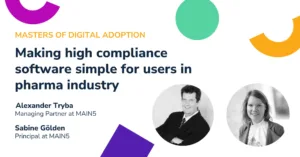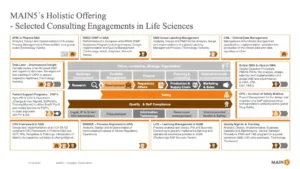Making high compliance software simple for users in pharma industry

In this Masters of Digital Adoption interview, we spoke with our partners at MAIN5 on the issue of digital adoption within the Pharmaceutical and life science industry. The training requirements for software in this industry throw up many challenges, from GxP regulations, to the complex processes that have to be completed. Sabine and Alex have provided their best practice advice on how to navigate these challenges.
Alexander Tryba:
MAIN5 is an established consultancy in the pharmaceutical industry, celebrating our 10 year anniversary this year. MAIN5 was founded on extensive industry experience and a want to improve the industry. As Managing Partner, I am responsible for compliance and learning management topics that our customers are facing. A highly important topic for this industry, as systems used play a major role in ensuring patient safety, product quality and data integrity.
Sabine Gölden:
I have been with MAIN5 for 9 years, and my current role is as a Principle Consultant. In my time in the role, I have witnessed a growing demand on training that meets the needs of the users, as well as compliance and regulation.

Table of Contents
Firstly, can you please explain the typical use cases for life sciences software and the regulations that are in place?
Alexander:
Through the life cycle of product development within the pharmaceutical industry, there are a variety of technologies used, from research through to marketing and sales. All of these are governed by quality and GxP compliance rules. Requirements also differ from company to company, depending on geography and many other factors. There is not a one size fits all approach.
Data integrity is at the core of all technology use in this industry, as this is vital for not just developing products, but getting authorisation of new drugs in the market.
Here is an overview of the softwares used in the life cycle of product development:

Sabine:
In the majority of cases, guidance is provided for users on the systems, but it is often very high level detail. Regulations state that training should be evaluated for effectiveness, training needs to be documented and people need to be trained in an appropriate manner. However, no detail is provided on how to assess this. Businesses can interpret this guidance in many different ways, making it particularly challenging.
Compliance is extremely important though, and that has resulted in extremely detailed training guides being created. But, employees are expected to read a 100 page document and become experts on the system straight away. This is not a suitable format or approach to get people trained.
Alexander:
We also have to consider these are cloud systems that run 3-4 major releases each year. So that adds to the need to keep employees trained on the latest updated processes. This also adds to the pressure to keep training materials up to date, with new screenshots being added to the training material so they don’t become outdated overnight.
Could you provide an overview of the awareness of digital adoption for your customers, and if they are usually successful at it?
Sabine:
Our customers are aware they need to have employees digitally adopt new software. But it is not a big strategy for them.
Alexander:
Digital adoption is part of the unknown. There has not been a solution for this pain point before. A lot of education is needed so people are aware that there is a solution to these problems that can make a difference to patient safety, product quality and data integrity.
What are the key factors that make digital adoption so important, yet also challenging, for the life sciences and pharma companies?
Sabine:
Digital adoption can help get people trained for their daily tasks and avoid any overdue trainings that hinder them from completing their tasks.
A Digital Adoption Platform, like Userlane, can help by:
- Serving people the right training at the right time so you can avoid delays. You do not need to predict which users need to be taught as user segmentation is able to make the targeting simple.
- Avoid overdue training and delaying users from entering the system. If training is not relevant to users, they will ignore it. By targeting users, this can be avoided.
- Provides moment of need training which is good for people who learn differently.
- Customized training allows you to map training to unique needs of every employee.
What would be your top digital adoption best practices that will help a business overcome these challenges?
Sabine:
- Be clear on digital strategy by setting OKRs. Very ambitious strategies that have not been properly implemented are often dropped when they run into problems.
- Stakeholder management. You need clear buy in from leadership and the people taking responsibility for changes.
- Investment needs to be sustainable. Once the system is up and running, the project does not finish. There needs to be continuity, else you frustrate the users.
How do you think digital adoption platforms support these best practices?
Alex:
We assume that guided onboarding and providing focussed learning content at the time of need would be a big advantage compared to traditional learning approaches.
In addition, integrated Analytics can generate insights to lever the learning success. DAPs are offering built-in analytics that track user engagement, performance and adoption rates. And the possible integration with existing systems can promote a seamless and efficient workflow across various platforms and technologies.
Sabine:
From my experience, I can foresee the following benefits:
- E-learning content that is served at the time of need is a big advantage for users.
- Data insights on what training demands are across the business, and gather real user feedback to understand how employees feel on the system.
- Creating seamless experiences across applications. Guiding a user across a number of different systems.
- A DAP can help make the most unintuitive systems, simple to use.
- It doesn’t have to be that the user has to adapt to the application, a DAP flips it to make the system easy for the user.
What would be your 1 piece of advice for mastering digital adoption?
Our one piece of advice for mastering digital adoption would be to foster a culture of continuous learning, innovation, and adaptability within the client organization. Embracing this mindset will help employees become more open to change, encourage collaboration, and drive the successful implementation and adoption of new digital tools and technologies.

